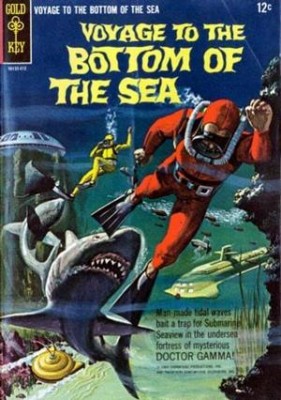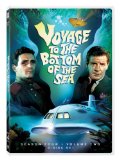| Reviews & Columns |
|
Reviews DVD TV on DVD Blu-ray 4K UHD International DVDs In Theaters Reviews by Studio Video Games Features Collector Series DVDs Easter Egg Database Interviews DVD Talk Radio Feature Articles Columns Anime Talk DVD Savant Horror DVDs The M.O.D. Squad Art House HD Talk Silent DVD
|
DVD Talk Forum |
|
|
| Resources |
|
DVD Price Search Customer Service #'s RCE Info Links |
|
Columns
|
|
|
Voyage to the Bottom of the Sea - Season Four, Volume Two
But like each and every Irwin Allen show that followed, Voyage sank like a stone, or more accurately the non-buoyant icebergs of the 1961 feature film (and again in stock footage on the TV series). Bereft of taste, for Allen no teleplay was too absurd or insultingly stupid, and like his Lost in Space, The Time Tunnel, and Land of the Giants, Voyage to the Bottom of the Sea was soon turned over to Allen's stable of hack directors and writers like Jerry Hopper and William Welch.
What's most unfortunate about Voyage's pathetic final episodes is that the show still looks just great. The special effects and art direction far eclipse the imaginative and intelligent but visually garish look of Star Trek, then running concurrent with Voyage. On the other hand, Allen notoriously shot his wad at the beginning of each season, blowing budgets on the season-opener at the expense of everything that followed, and his cost-cutting measures, so apparent in these episodes, is alternately depressing and hilarious. Generally though, as with Voyage's last few seasons, following typically action-packed openings, most episodes give way to 45 minutes of mind-numbing boredom.
Voyage to the Bottom of the Sea - Season Four, Volume Two arrives nearly two full years after the release of Volume One. Why the delay? Over at the Classic Horror Film Board historian and Voyage fan Tom Weaver suggests "sales figures were at the bottom of the sea." Probably so. I recommend this lively, amusing discussion, which mercilessly nails the series' faults - and these are the show's fans.
Fox's DVD of the series looks phenomenally good. Episodes have splendid, bright color and are impressively sharp and pristine, all of which is highly ironic considering how bad things got by season four ("polishing a turd," is how fan Jeff Flugel accurately describes it). Extra features consist mainly of recycled material, much like the show.
Recapping: Voyage to the Bottom of the Sea chronicles the adventures of the crew of the Seaview, a futuristic atomic submarine. The movie starred Walter Pidgeon as Admiral Harriman Nelson and Robert Sterling as Captain Lee Crane, while the 1964-68 TV series top-lined Richard Basehart as Nelson and David Hedison as Crane, with only Del Monroe, in the relatively minor role of Kowalski, returning from the film. Other regulars include Terry Becker as Chief Sharkey, Arch Whiting as Sparks, Paul Trinka as Patterson, and Robert Dowdell as Lt. Commander Chip Morton. Despite the large crew, by season four these are the only crewmen who ever seem to talk. Cheapskate Allen was loathe paying the extra $40 (or whatever*) to bump an extra or two up to bit-player status to deliver a few lines. This results in many long and awkward stretches of silence, with most of the crew acting like Carthusian monks.
The disregard for science is pitiful. It's one thing to ask an audience to suspend disbelief, but on Voyage the science is so outrageously wrong even the children that by this time made up its core audience knew better. In "Secret of the Deep" a colossal sperm whale is identified as a big fish. In "The Abominable Snowman," the title creature isn't discovered in the Himalayas, but rather among icebergs "a hundred miles from the South Pole." What happened to Antarctica? Only a producer like Irwin Allen would lose an entire continent.
As stated above, the pre-titles prologue to each show usually generates some excitement, but the drama that follows is dull beyond words. Most of the episodes are "bottle shows" - with that week's menace and all of the conflict confined to the Seaview's bridge, utilitarian corridors, and an all-purpose circuitry room, providing the menace something to mess around with, invariably knocking things over and generating a lot of smoke and electrical sparks - and thus saving Allen the expense of building new sets. Even when new sets and monster suits turn up, they're usually second-hand knock-offs seen on Allen's other shows, and when Nelson and/or Crane actually venture outside the sub, it's usually to confront stock footage from earlier episodes, or endlessly recycled bits from the Voyage to the Bottom of the Sea movie. The original pilot, included in this volume, makes a striking contrast to what the show once was.
In most episodes, the crew and this week's monster play hide-and-seek fore and aft, up and down the sub's drab corridors, the creature usually picking off those non-speaking crewmen one-by-one while finding time to sabotage the vessel, or steal its nuclear rods (played by plastic tubing in one show).
The teleplays are ripe with shamelessly padded dialogue serving no purpose except to burn as much running time as humanly possible. Consider this sequence, with Crane in a huddle in the corridor with the ship's doctor (semi-regular Richard Bull), while Admiral Nelson is in his office, speaking to Crane on the ship's intercom:
Nelson: What about Paulsen and Rayburn?
Doc [to Crane] : Paulsen was just coming to when I got the call to come up here.
Crane: Why wasn't I notified?
Doc: There wasn't time. Besides, he's too weak to answer any questions now.
Nelson: What is it, Lee?
Crane: Apparently, Dr. Paulsen just came to.
Nelson: Is he well enough to be questioned?
Crane: No, sir. He's not. He's still too weak, according to the doc.
All this inanity must have been hell on the regular cast who go through the same motions week-in and week-out with their paper-thin characters. In "The Lobster Man," guest-starring Victor Lundin as an anthropomorphic crustacean (though he more closely resembles Brown Gargantua in a raincoat**), poor Richard Basehart looks like he's finally had it. His look of total disgust is like an open wound. He barely reacts when first introduced to the talking lobster-man from outer space, and throughout the episode avoids making eye contact with the creature, instead looking ready to bolt any second. His appalled reactions actually make this episode almost fun to watch.
(To his great credit, David Hedison contrastingly gives it his all, right up until the bitter end. Hedison genuinely tries to sell each ludicrous premise, never giving less than 100%.)
Even the stories are recycled, with yet more alien invaders (three in a row here), two time travel stories, and more (please, God, no!) episodes about imposter crewmen and Nelson and/or Crane-into monster yarns. Episode titles are either hopelessly vague ("Edge of Doom," "Attack!" "No Way Back") or emblematic of the show's decline: "The Return of Blackbeard," "Terrible Leprechaun," "The Lobster Man," etc.
Guest stars this final half-season, most favorites of Allen, include: Malachi Throne, Walter Burke, Victor Lundin, Paul Mantee (meaning both stars of the great Robinson Crusoe on Mars appeared in embarrassing roles one week apart), Peter Mark Richman, Michael Pate, Kevin Hagen, Skip Homeier, Henry Jones, and Barry Atwater.
Video & Audio
At least Voyage to the Bottom of the Sea continues to look great, almost flawless in fact. (Can a Blu-ray set be far behind?) Episodes appear uncut and are not time-compressed, with 13 episodes spread over three double-sided discs, two or three per side. Audio is 1.0 Dolby Digital mono with an optional French track and English SDH subtitles. Some episodes include an "In Color" placard at the beginning.
Extra Features
Supplements include, for the umpteenth time, another version of the pilot, "Eleven Days to Zero," this time in black and white and, for the first time, with the original commercials intact (for deodorant, appropriately). Another cut of the pilot, also in black and white but without commercials, is also included, as well as a modest still gallery.
Parting Thoughts
Kudos to Fox for finally finishing off their '60s-era Irwin Allen shows, and while the shows themselves are quite terrible, few would begrudge nostalgic fans, most of whom are already aware of the program's shortcomings, their pleasure in revisiting them. But all others be warned: if ever there was a "for fans only" title, this is it.
* TV historian Stephen Bowie writes, "Just in the dept. of utter trivia, I was looking at the production records of Naked City (1960-63) in L.A. last month, and the one-line actors got $90-$100. Of course, that's New York and Voyage was L.A. and five years later, but it's a ballpark figure, at least." Stephen's great blog is Classic TV History.
* Brown Gargantua being one of the stars of 1966's War of the Gargantuas, a Japanese film.
Film historian Stuart Galbraith IV's latest book, The Toho Studios Story, is on sale now.
|
| Popular Reviews |
| Sponsored Links |
|
|
| Sponsored Links |
|
|
| Release List | Reviews | Shop | Newsletter | Forum | DVD Giveaways | Blu-Ray | Advertise |
|
Copyright 2024 DVDTalk.com All Rights Reserved. Legal Info, Privacy Policy, Terms of Use,
Manage Preferences,
Your Privacy Choices | |||||||
















